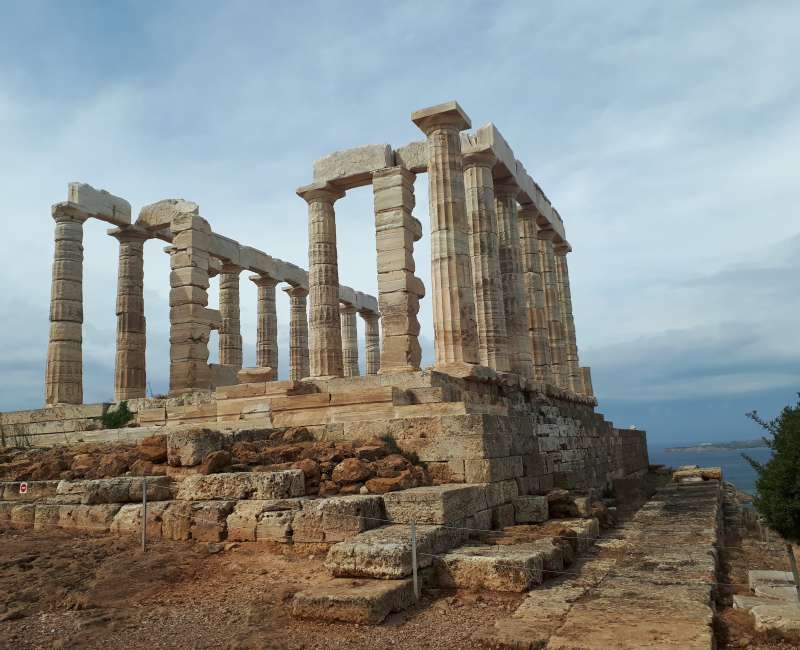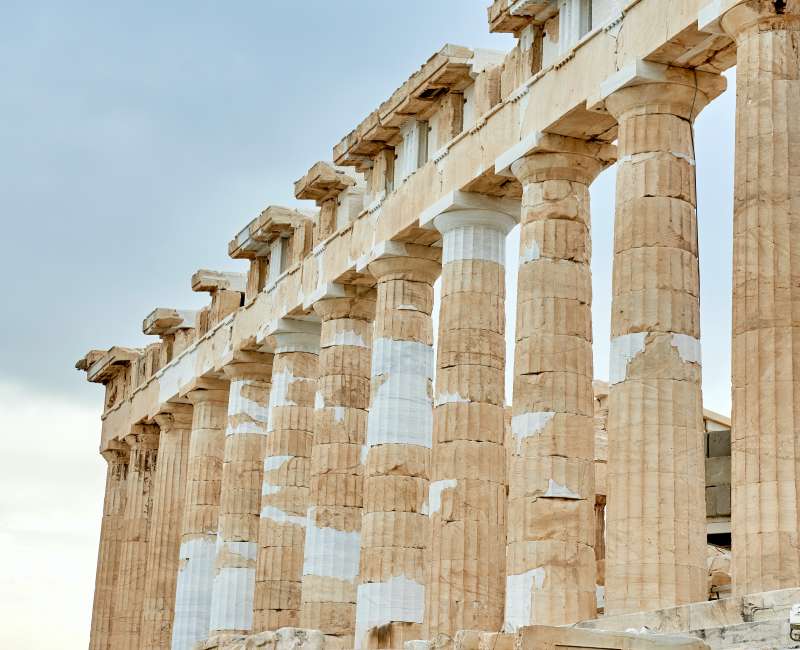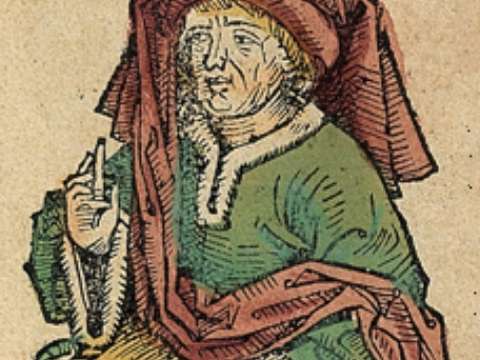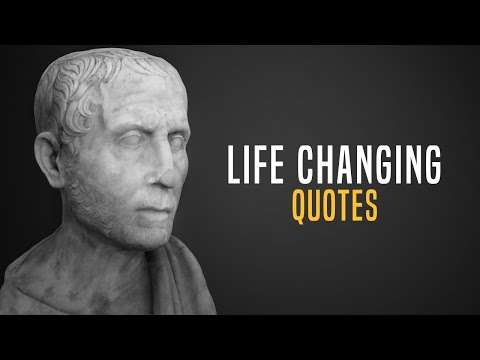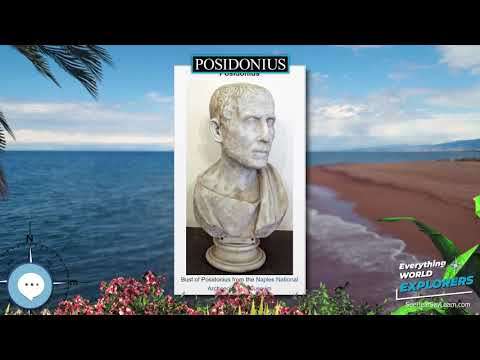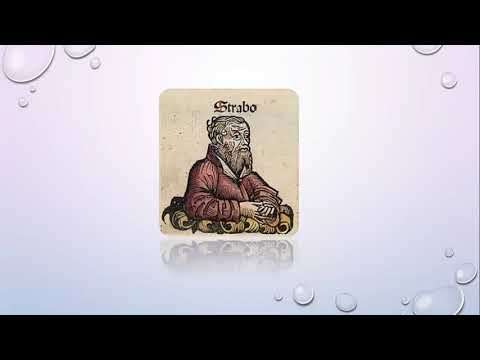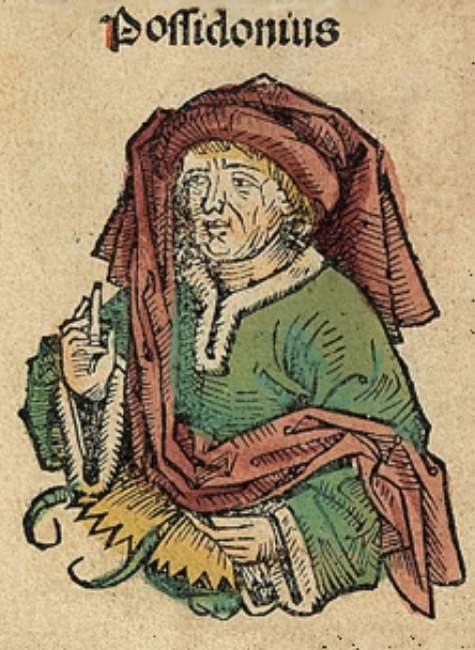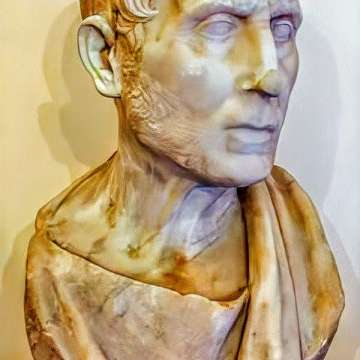

Posidonius (0135 B.C.-0051)
Riches are a cause of evil, not because, of themselves, they do any evil, but because they goad men on so that they are ready to do evil.
Posidonius, Poseidonios, meaning "of Poseidon" "of Apameia" or of Rhodes", was a Greek politician, astronomer, astrologer, geographer, historian, mathematician, and teacher native to Apamea, Syria. He is most remembered as a philosopher, initially as a Stoic, but ultimately rejecting Stoicism to become an Aristotelian.
He was acclaimed as the greatest polymath of his age. His vast body of work exists today only in fragments. Following the basic doctrine of Stoicism about a rationally directed universe, he focused on human nature. He thought that the world is arranged for the benefit of mankind, placing astrology beyond human knowledge; although studying astrology, contributed into making the universe approachable to humans.
Writers such as Strabo and Seneca provide most of the information, from history, about his life.
Early life
Posidonius, nicknamed "the Athlete", was born to a Greek family in Apamea, a Hellenistic city on the river Orontes in northern Syria.
Posidonius completed his higher education in Athens, where he was a student of the aged Panaetius, the head of the Stoic school. But soon he came in conflict with the Stoic doctrines and was involved in heated debates with many other Stoic philosophers of the school. The incidents concerning Posidonius's conflict and final break up with the Stoics are mentioned by Galen in his book On the Doctrines of Plato and Hippocrates. Eventually Posidonius gave up Stoicism and turned to a different philosophical direction, this of Plato but mainly of Aristotle, remaining a faithful follower of Aristotelian doctrines until his death.
He settled around 95 BCE in Rhodes, a maritime state which had a reputation for scientific research, and became a citizen.
Career
In Rhodes, Posidonius actively took part in political life, and his high standing is apparent from the offices he held. He attained the highest public office as one of the Prytaneis presidents, having a six months tenure of Rhodes. He served as an ambassador to Rome in 87–86 BCE, during the Marian and Sullan era.
Along with other Greek intellectuals, Posidonius favored Rome as the stabilizing power in a turbulent world. His connections to the Roman ruling class were for him not only politically important and sensible but were also important to his scientific research. His entry into government provided Posidonius with powerful connections to facilitate his travels to far away places, even beyond Roman control.
After he had established himself in Rhodes, Posidonius made one or more journeys traveling throughout the Roman world and even beyond its boundaries to conduct scientific research. He traveled in Greece, Hispania, Italy, Sicily, Dalmatia, Gaul, Liguria, North Africa, and on the eastern shores of the Adriatic.
In Hispania, on the Atlantic coast at Gades the modern Cadiz, Posidonius could observe tides much higher than in his native Mediterranean. He wrote that daily tides are related to the Moon's orbit, while tidal heights vary with the cycles of the Moon, and he hypothesized about yearly tidal cycles synchronized with the equinoxes and solstices.
In Gaul, he studied the Celts. He left vivid descriptions of things he saw with his own eyes while among them: men who were paid to allow their throats to be slit for public amusement and the nailing of skulls as trophies to the doorways. But he noted that the Celts honored the Druids, whom Posidonius saw as philosophers, and concluded that, even among the barbaric, "pride and passion give way to wisdom, and Ares stands in awe of the Muses." He wrote a geographic treatise on the lands of the Celts which has since been lost, but which is referred to extensively both directly and otherwise in the works of Diodorus of Sicily, Strabo, Caesar and Tacitus' Germania.
School
Posidonius's extensive writings and lectures gave him authority as a scholar and made him famous everywhere in the Graeco-Roman world, and a school grew around him in Rhodes. His grandson Jason, who was the son of his daughter and Menekrates of Nysa, followed in his footsteps and continued Posidonius's school in Rhodes. Although little is known of the organization of his school, it is clear that Posidonius had a steady stream of Greek and Roman students.
Partial scope of writings
Posidonius was celebrated as a polymath throughout the Graeco-Roman world because he came near to mastering all the knowledge of his time, similar to Aristotle and Eratosthenes. He attempted to create a unified system for understanding the human intellect and the universe which would provide an explanation of and a guide for human behavior.
Posidonius wrote on physics including meteorology and physical geography, astronomy, astrology and divination, seismology, geology and mineralogy, hydrology, botany, ethics, logic, mathematics, history, natural history, anthropology, and tactics. His studies were major investigations into their subjects, although not without errors.
Wilhelm Capelle Neue Jahrbücher, 1905, traced most of the doctrines of De Mundo, to Poseidonius, a popular philosophic treatise based on two works of Poseidonius.
None of his works survive intact. All that have been found are fragments, although the titles and subjects of many of his books are known.
Philosophy
For Posidonius, philosophy was the dominant master art and all the individual sciences were subordinate to philosophy, which alone could explain the cosmos. All his works, from scientific to historical, were inseparably philosophical.
He accepted the Stoic categorization of philosophy into physics natural philosophy, including metaphysics and theology, logic including dialectic, and ethics. These three categories for him were, in Stoic fashion, inseparable and interdependent parts of an organic, natural whole. He compared them to a living being, with physics the meat and blood, logic the bones and tendons holding the organism together, and finally ethics – the most important part – corresponding to the soul. His philosophical grand vision was that the universe itself was similarly interconnected, as if an organism, through cosmic "sympathy", in all respects from the development of the physical world to the history of humanity.
On the vast majority of philosophical issues, what we know of both Panaetius and Posidonius places them firmly within the main current of Stoic debate. Their innovatively hospitable attitude to Plato and Aristotle enables them to enrich and, to a limited extent, reorientate their inherited Stoicism, but, for all that, they remain palpably Stoics, working within the established tradition.
Although a firm Stoic, Posidonius was, like Panaetius and other Stoics of the middle period, eclectic. He followed not only the older Stoics, but also Plato and Aristotle. Although it is not certain, Posidonius may have written a commentary on Plato's Timaeus.
He was the first Stoic to depart from the orthodox doctrine that passions were faulty judgments and posit that Plato's view of the soul had been correct, namely that passions were inherent in human nature. In addition to the rational faculties, Posidonius taught that the human soul had faculties that were spirited anger, desires for power, possessions, etc. and desiderative desires for sex and food. Ethics was the problem of how to deal with these passions and restore reason as the dominant faculty.
Physics
In physics, Posidonius advocated a theory of cosmic "sympathy" συμπάθεια, sumpatheia, the organic interrelation of all appearances in the world, from the sky to the earth, as part of a rational design uniting humanity and all things in the universe, even those that were temporally and spatially separate. Although his teacher Panaetius had doubted divination, Posidonius used Platonic philosophy to support his belief in divination – whether through astrology or prophetic dreams – as a kind of scientific prediction.
Astronomy
Some fragments of his writings on astronomy survive through the treatise by Cleomedes, On the Circular Motions of the Celestial Bodies, the first chapter of the second book appearing to have been mostly copied from Posidonius.
Posidonius advanced the theory that the Sun emanated a vital force which permeated the world.
He attempted to measure the distance and size of the Sun. In about 90 BCE, Posidonius estimated the distance from the Earth to the Sun see astronomical unit to be 9,893 times the Earth's radius. This was still too small by half. In measuring the size of the Sun, however, he reached a figure larger and more accurate than those proposed by other Greek astronomers and Aristarchus of Samos.
Posidonius also calculated the size and distance of the Moon.
Posidonius constructed an orrery, possibly similar to the Antikythera mechanism. Posidonius's orrery, according to Cicero, exhibited the diurnal motions of the Sun, Moon, and the five known planets.
Geography, ethnology, and geology
Posidonius's fame beyond specialized philosophical circles had begun, at the latest, in the eighties with the publication of the work "about the ocean and the adjacent areas". This work was not only an overall representation of geographical questions according to current scientific knowledge, but it served to popularize his theories about the internal connections of the world, to show how all the forces had an effect on each other and how the interconnectedness applied also to human life, to the political just as to the personal spheres.
In this work, Posidonius detailed his theory of the effect on a people's character by the climate, which included his representation of the "geography of the races". This theory was not solely scientific, but also had political implications—his Roman readers were informed that the climatic central position of Italy was an essential condition of the Roman destiny to dominate the world. As a Stoic, he did not, however, make a fundamental distinction between the civilized Romans as masters of the world and the less civilized peoples.

Like Pytheas, Posidonius believed the tide is caused by the Moon. Posidonius was, however, wrong about the cause. Thinking that the Moon was a mixture of air and fire, he attributed the cause of the tides to the heat of the Moon, hot enough to cause the water to swell but not hot enough to evaporate it.
He recorded observations on both earthquakes and volcanoes, including accounts of the eruptions of the volcanoes in the Aeolian Islands, north of Sicily.
Earth's circumference
Posidonius calculated the Earth's circumference by reference to the position of the star Canopus. As explained by Cleomedes, Posidonius observed Canopus on but never above the horizon at Rhodes, while at Alexandria he saw it ascend as far as 7½ degrees above the horizon the meridian arc between the latitude of the two locales is actually 5 degrees 14 minutes. Since he thought Rhodes was 5,000 stadia due north of Alexandria, and the difference in the star's elevation indicated the distance between the two locales was 1/48 of the circle, he multiplied 5,000 by 48 to arrive at a figure of 240,000 stadia for the circumference of the Earth.
His estimate of the latitude difference of these two points, 360/48=7.5, is rather erroneous. The modern value is approximately 5 degrees. In addition, they are not quite on the same meridian as they supposed to be. The longitude difference of the points, slightly less than 2 degrees, is not negligible compared with the latitude difference.
Translating stadia into modern units of distance can be problematic, but it is generally thought that the stadium used by Posidonius was almost exactly 1/10 of a modern statute mile. Thus Posidonius's measure of 240,000 stadia translates to 24,000 mi 39,000 km compared to the actual circumference of 24,901 mi 40,074 km.

Posidonius was informed in his approach to finding the Earth's circumference by Eratosthenes, who a century earlier arrived at a figure of 252,000 stadia; both men's figures for the Earth's circumference were uncannily accurate.
Strabo noted that the distance between Rhodes and Alexandria is 3,750 stadia, and reported Posidonius's estimate of the Earth's circumference to be 180,000 stadia or 18,000 mi 29,000 km. Pliny the Elder mentions Posidonius among his sources and without naming him reported his method for estimating the Earth's circumference. He noted, however, that Hipparchus had added some 26,000 stadia to Eratosthenes's estimate. The smaller value offered by Strabo and the different lengths of Greek and Roman stadia have created a persistent confusion around Posidonius's result. Ptolemy used Posidonius's lower value of 180,000 stades about 33% too low for the Earth's circumference in his Geography. This was the number used by Christopher Columbus to underestimate the distance to India as 70,000 stades.
Meteorology
Posidonius in his writings on meteorology followed Aristotle. He theorized on the causes of clouds, mist, wind, and rain as well as frost, hail, lightning, and rainbows. He also estimated that the boundary between the clouds and the heavens lies about 40 stadia above the Earth.
Mathematics
Posidonius was one of the first to attempt to prove Euclid's fifth postulate of geometry. He suggested changing the definition of parallel straight lines to an equivalent statement that would allow him to prove the fifth postulate. From there, Euclidean geometry could be restructured, placing the fifth postulate among the theorems instead.
In addition to his writings on geometry, Posidonius was credited for creating some mathematical definitions, or for articulating views on technical terms, for example 'theorem' and 'problem'.
History and tactics
In his Histories, Posidonius continued the World History of Polybius. His history of the period 146 – 88 BCE is said to have filled 52 volumes. His Histories continue the account of the rise and expansion of Roman dominance, which he appears to have supported. Posidonius did not follow Polybius's more detached and factual style, for Posidonius saw events as caused by human psychology; while he understood human passions and follies, he did not pardon or excuse them in his historical writing, using his narrative skill in fact to enlist the readers' approval or condemnation.
For Posidonius "history" extended beyond the earth into the sky; humanity was not isolated each in its own political history, but was a part of the cosmos. His Histories were not, therefore, concerned with isolated political history of peoples and individuals, but they included discussions of all forces and factors geographical factors, mineral resources, climate, nutrition, which let humans act and be a part of their environment. For example, Posidonius considered the climate of Arabia and the life-giving strength of the sun, tides taken from his book on the oceans, and climatic theory to explain people's ethnic or national characters.
Of Posidonius's work on tactics, The Art of War, the Greek historian Arrian complained that it was written 'for experts', which suggests that Posidonius may have had first hand experience of military leadership or, perhaps, used knowledge he gained from his acquaintance with Pompey.
On the Jews
Posidonius's writings on the Jews were probably the source of Diodorus Siculus's account of the siege of Jerusalem and possibly also for Strabo's. Some of Posidonius's arguments are contested by Josephus in Against Apion.
Reputation and influence
In his own era, his writings on almost all the principal divisions of philosophy made Posidonius a renowned international figure throughout the Graeco-Roman world and he was widely cited by writers of his era, including Cicero, Livy, Plutarch, Strabo who called Posidonius "the most learned of all philosophers of my time", Cleomedes, Seneca the Younger, Diodorus Siculus who used Posidonius as a source for his Bibliotheca historia , and others. Although his ornate and rhetorical style of writing passed out of fashion soon after his death, Posidonius was acclaimed during his life for his literary ability and as a stylist.
Posidonius was the major source of materials on the Celts of Gaul and was profusely quoted by Timagenes, Julius Caesar, the Sicilian Greek Diodorus Siculus, and the Greek geographer Strabo.
Posidonius appears to have moved with ease among the upper echelons of Roman society as an ambassador from Rhodes. He associated with some of the leading figures of late republican Rome, including Cicero and Pompey, both of whom visited him in Rhodes. In his twenties, Cicero attended his lectures 77 BCE and they continued to correspond. Cicero in his De Finibus closely followed Posidonius's presentation of Panaetius's ethical teachings.

Posidonius met Pompey when he was Rhodes's ambassador in Rome and Pompey visited him in Rhodes twice, once in 66 BCE during his campaign against the pirates and again in 62 BCE during his eastern campaigns, and asked Posidonius to write his biography. As a gesture of respect and great honor, Pompey lowered his fasces before Posidonius's door. Other Romans who visited Posidonius in Rhodes were Velleius, Cotta, and Lucilius.
Ptolemy was impressed by the sophistication of Posidonius's methods, which included correcting for the refraction of light passing through denser air near the horizon. Ptolemy's approval of Posidonius's result, rather than Eratosthenes's earlier and more correct figure, caused it to become the accepted value for the Earth's circumference for the next 1,500 years.
Posidonius fortified the Stoicism of the middle period with contemporary learning. Next to his teacher Panaetius, he did most, by writings and personal contacts, to spread Stoicism in the Roman world. A century later, Seneca referred to Posidonius as one of those who had made the largest contribution to philosophy.
His influence on philosophical thinking lasted until the Middle Ages, as is shown by citation in the Suda, the massive medieval lexicon.
At one time, scholars perceived Posidonius's influence in almost every subsequent writer, whether warranted or not. Today, Posidonius seems to be recognized as having had an inquiring and wide-ranging mind, not entirely original, but with a breadth of view that connected, in accordance with his underlying Stoic philosophy, all things and their causes and all knowledge into an overarching, unified world view.
The crater Posidonius on the Moon is named after him.
Death
Posidonius probably died in Rome or Rhodes in about 51 BCE.
More facts
Thessalus and Medea (2018)
The Cleopatras (1983)




















